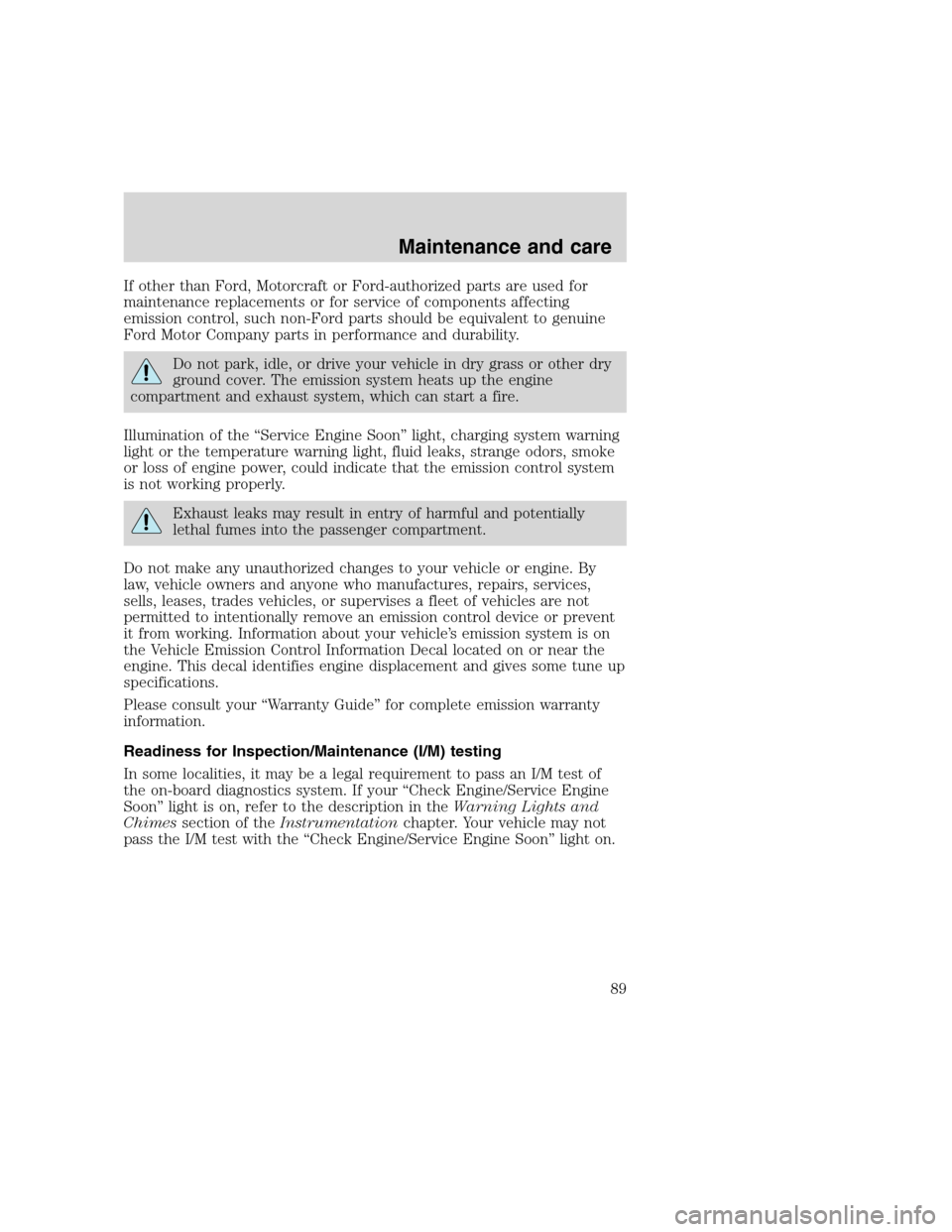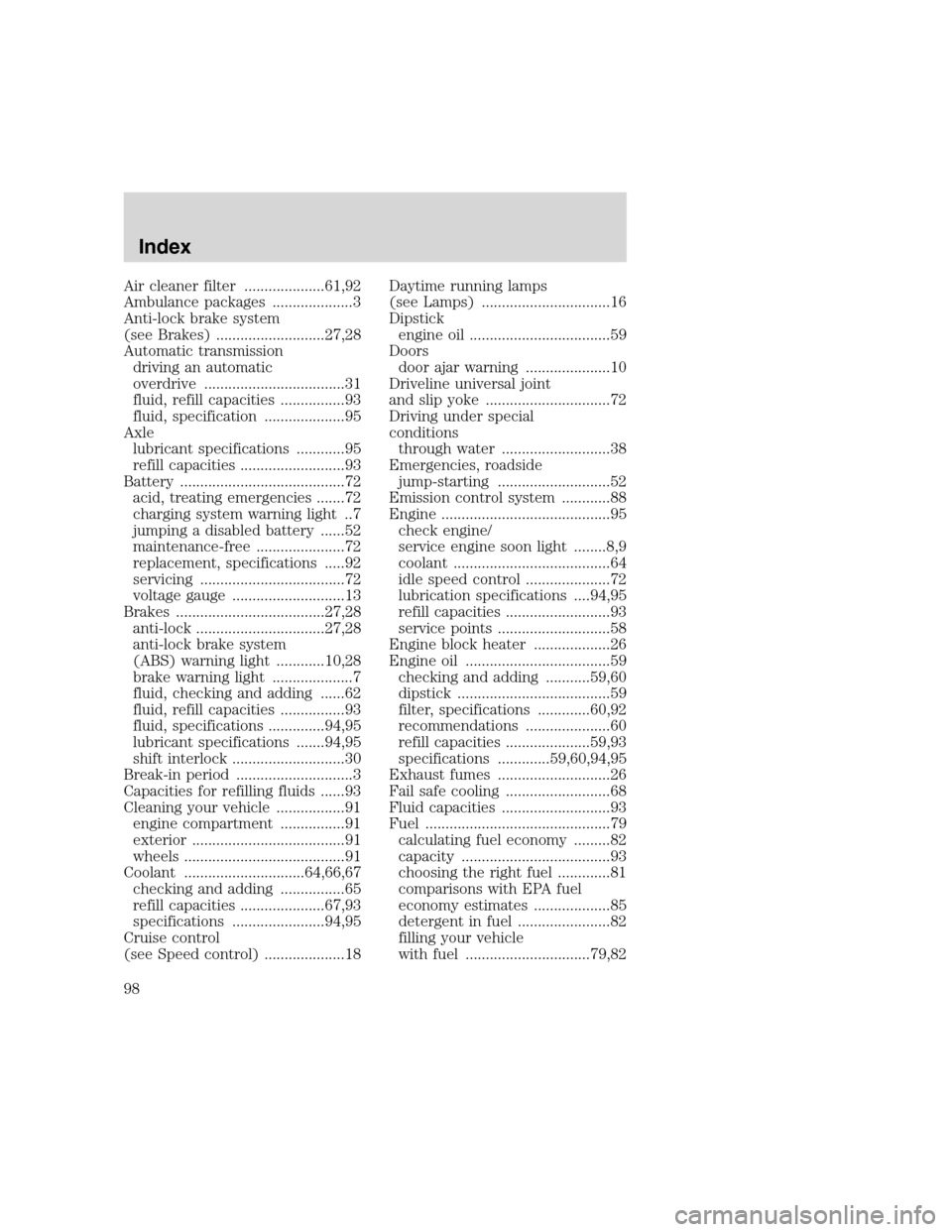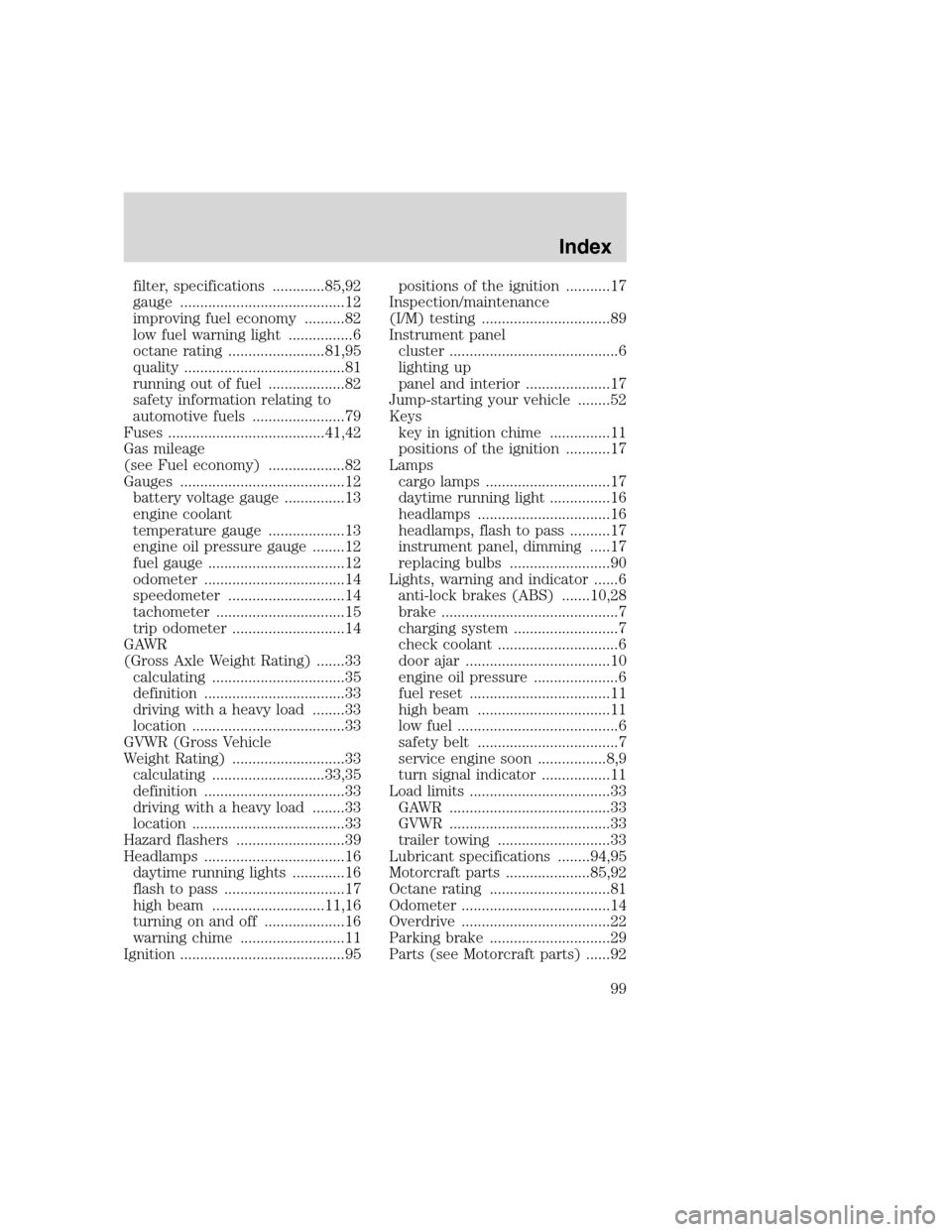2000 FORD F SERIES MOTORHOME AND COMMERCIAL CHASSIS charging
[x] Cancel search: chargingPage 7 of 104

Charging system
Illuminates when the ignition is
turned to the ON position and the
engine is off. The light also
illuminates when the battery is not
charging properly, requiring
electrical system service.
Brake system warning
Momentarily illuminates when the
ignition is turned to the ON
position. Also illuminates if the
parking brake is engaged. If the
brake warning lamp does not
illuminate at these times, seek service immediately. Illumination after
releasing the parking brake indicates low brake fluid level and the brake
system should be inspected immediately.
Safety belt
Momentarily illuminates when the
ignition is turned ON to remind you
to fasten your safety belts.
Brake reserve system warning (if equipped)
Illuminates to indicate normal
Hydromax booster reserve system
activation when the engine is OFF
and the service brake pedal is
applied, or when the ignition is in
the ON or START position.
This light may also illuminate momentarily if the engine is running and
the driver turns the steering wheel fully in one direction while braking.
If the light remains on while the engine is running, this indicates
inadequate hydraulic booster pressure or reserve pump system failure.
Safely stop the vehicle as soon as possible and seek service immediately.
BRAKE
Instrumentation
7
Page 73 of 104

If the electrolyte level in the battery is low, you can add plain tap water
to the battery, as long as you do not use hard water (water with a high
mineral or alkali content). If possible, however, try to only fill the battery
cells with distilled water. If the battery needs water often, have the
charging system checked.
If your battery has a cover/shield, make sure it is reinstalled
after the battery has been cleaned or replaced.
For longer, trouble-free operation, keep the top of the battery clean and
dry. Also, make certain the battery cables are always tightly fastened to
the battery terminals.
If you see any corrosion on the battery or terminals, remove the cables
from the terminals and clean with a wire brush. You can neutralize the
acid with a solution of baking soda and water.
Batteries normally produce explosive gases which can cause
personal injury. Therefore, do not allow flames, sparks or lighted
substances to come near the battery. When working near the battery,
always shield your face and protect your eyes. Always provide proper
ventilation.
When lifting a plastic-cased battery, excessive pressure on the
end walls could cause acid to flow through the vent caps,
resulting in personal injury and/or damage to the vehicle or battery.
Lift the battery with a battery carrier or with your hands on opposite
corners.
Keep batteries out of reach of children. Batteries contain sulfuric
acid. Avoid contact with skin, eyes or clothing. Shield your eyes
when working near the battery to protect against possible splashing of
acid solution. In case of acid contact with skin or eyes, flush
immediately with water for a minimum of 15 minutes and get prompt
medical attention. If acid is swallowed, call a physician immediately.
To account for customer driving habits and conditions, your automatic
transmission electronically controls the shift quality by using an adaptive
learning strategy. The adaptive learning strategy is maintained by power
from the battery. When the battery is disconnected or a new battery is
installed, the transmission must relearn its adaptive strategy. Optimal
Maintenance and care
73
Page 89 of 104

If other than Ford, Motorcraft or Ford-authorized parts are used for
maintenance replacements or for service of components affecting
emission control, such non-Ford parts should be equivalent to genuine
Ford Motor Company parts in performance and durability.
Do not park, idle, or drive your vehicle in dry grass or other dry
ground cover. The emission system heats up the engine
compartment and exhaust system, which can start a fire.
Illumination of the “Service Engine Soon” light, charging system warning
light or the temperature warning light, fluid leaks, strange odors, smoke
or loss of engine power, could indicate that the emission control system
is not working properly.
Exhaust leaks may result in entry of harmful and potentially
lethal fumes into the passenger compartment.
Do not make any unauthorized changes to your vehicle or engine. By
law, vehicle owners and anyone who manufactures, repairs, services,
sells, leases, trades vehicles, or supervises a fleet of vehicles are not
permitted to intentionally remove an emission control device or prevent
it from working. Information about your vehicle’s emission system is on
the Vehicle Emission Control Information Decal located on or near the
engine. This decal identifies engine displacement and gives some tune up
specifications.
Please consult your “Warranty Guide” for complete emission warranty
information.
Readiness for Inspection/Maintenance (I/M) testing
In some localities, it may be a legal requirement to pass an I/M test of
the on-board diagnostics system. If your “Check Engine/Service Engine
Soon” light is on, refer to the description in theWarning Lights and
Chimessection of theInstrumentationchapter. Your vehicle may not
pass the I/M test with the “Check Engine/Service Engine Soon” light on.
Maintenance and care
89
Page 98 of 104

Air cleaner filter ....................61,92
Ambulance packages ....................3
Anti-lock brake system
(see Brakes) ...........................27,28
Automatic transmission
driving an automatic
overdrive ...................................31
fluid, refill capacities ................93
fluid, specification ....................95
Axle
lubricant specifications ............95
refill capacities ..........................93
Battery .........................................72
acid, treating emergencies .......72
charging system warning light ..7
jumping a disabled battery ......52
maintenance-free ......................72
replacement, specifications .....92
servicing ....................................72
voltage gauge ............................13
Brakes .....................................27,28
anti-lock ................................27,28
anti-lock brake system
(ABS) warning light ............10,28
brake warning light ....................7
fluid, checking and adding ......62
fluid, refill capacities ................93
fluid, specifications ..............94,95
lubricant specifications .......94,95
shift interlock ............................30
Break-in period .............................3
Capacities for refilling fluids ......93
Cleaning your vehicle .................91
engine compartment ................91
exterior ......................................91
wheels ........................................91
Coolant ..............................64,66,67
checking and adding ................65
refill capacities .....................67,93
specifications .......................94,95
Cruise control
(see Speed control) ....................18Daytime running lamps
(see Lamps) ................................16
Dipstick
engine oil ...................................59
Doors
door ajar warning .....................10
Driveline universal joint
and slip yoke ...............................72
Driving under special
conditions
through water ...........................38
Emergencies, roadside
jump-starting ............................52
Emission control system ............88
Engine ..........................................95
check engine/
service engine soon light ........8,9
coolant .......................................64
idle speed control .....................72
lubrication specifications ....94,95
refill capacities ..........................93
service points ............................58
Engine block heater ...................26
Engine oil ....................................59
checking and adding ...........59,60
dipstick ......................................59
filter, specifications .............60,92
recommendations .....................60
refill capacities .....................59,93
specifications .............59,60,94,95
Exhaust fumes ............................26
Fail safe cooling ..........................68
Fluid capacities ...........................93
Fuel ..............................................79
calculating fuel economy .........82
capacity .....................................93
choosing the right fuel .............81
comparisons with EPA fuel
economy estimates ...................85
detergent in fuel .......................82
filling your vehicle
with fuel ...............................79,82
Index
98
Page 99 of 104

filter, specifications .............85,92
gauge .........................................12
improving fuel economy ..........82
low fuel warning light ................6
octane rating ........................81,95
quality ........................................81
running out of fuel ...................82
safety information relating to
automotive fuels .......................79
Fuses .......................................41,42
Gas mileage
(see Fuel economy) ...................82
Gauges .........................................12
battery voltage gauge ...............13
engine coolant
temperature gauge ...................13
engine oil pressure gauge ........12
fuel gauge ..................................12
odometer ...................................14
speedometer .............................14
tachometer ................................15
trip odometer ............................14
GAWR
(Gross Axle Weight Rating) .......33
calculating .................................35
definition ...................................33
driving with a heavy load ........33
location ......................................33
GVWR (Gross Vehicle
Weight Rating) ............................33
calculating ............................33,35
definition ...................................33
driving with a heavy load ........33
location ......................................33
Hazard flashers ...........................39
Headlamps ...................................16
daytime running lights .............16
flash to pass ..............................17
high beam ............................11,16
turning on and off ....................16
warning chime ..........................11
Ignition .........................................95positions of the ignition ...........17
Inspection/maintenance
(I/M) testing ................................89
Instrument panel
cluster ..........................................6
lighting up
panel and interior .....................17
Jump-starting your vehicle ........52
Keys
key in ignition chime ...............11
positions of the ignition ...........17
Lamps
cargo lamps ...............................17
daytime running light ...............16
headlamps .................................16
headlamps, flash to pass ..........17
instrument panel, dimming .....17
replacing bulbs .........................90
Lights, warning and indicator ......6
anti-lock brakes (ABS) .......10,28
brake ............................................7
charging system ..........................7
check coolant ..............................6
door ajar ....................................10
engine oil pressure .....................6
fuel reset ...................................11
high beam .................................11
low fuel ........................................6
safety belt ...................................7
service engine soon .................8,9
turn signal indicator .................11
Load limits ...................................33
GAWR ........................................33
GVWR ........................................33
trailer towing ............................33
Lubricant specifications ........94,95
Motorcraft parts .....................85,92
Octane rating ..............................81
Odometer .....................................14
Overdrive .....................................22
Parking brake ..............................29
Parts (see Motorcraft parts) ......92
Index
99